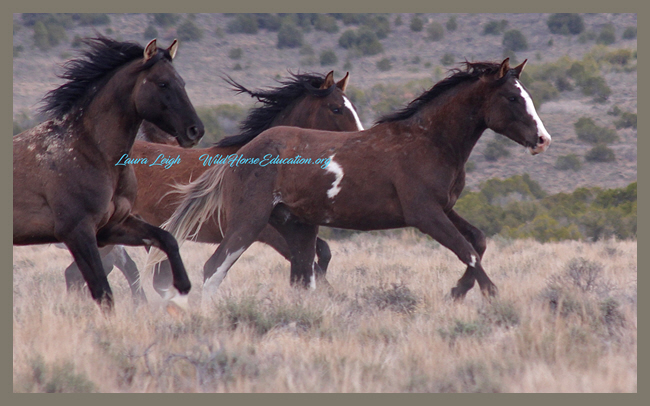Wild Horse Education Response Document:
BLM Report to Congress Management Options for a Sustainable Wild Horse and Burro Program (2018)
By Laura Leigh
Summary
The Bureau of Land Management (BLM) has presented a report to Congress as required by law. Congress requested a report on the BLM wild horse and burro program. The Consolidated Appropriations Act of 2017 (Public Law 115-31), requires this compliance.
BLM manages wild horses and burros on 26.9 million acres of the 258 million surface and subsurface public lands in their jurisdiction. Wild horses exist on about 11% of BLM managed lands.
BLM makes a claim that their management goal for the Wild Horse and Burro Program (WHB Program) is to “ensure healthy wild horses and burros on thriving public rangelands.” This assertion has been nothing more than a public relations statement that is not carried out in practice. The agency repeatedly scapegoats the WHB program as land managers continue to repeat long ingrained patterns including: ignoring extreme deficits within the (much larger) livestock grazing program, diverting personnel from the WHB program to placate other concerns, prioritizing existing funding based on political pressure and not rangeland (healthy horses, healthy range) needs.
The agency continues to use the excuse that a provision in the 1971 Wild Free-Roaming Horses and Burros Act, as amended, is a necessity as they are repeatedly hamstrung from using the 2004 Burns Rider that allowed wild horses to be sold to slaughter. BLM continually excludes that prior to the insertion of the stealth rider that BLM employees had been caught selling wild horses to slaughter, in contravention of existing law prior to 2004. Essentially BLM personnel were violating existing law for personal gain. The provisions to deny funding for slaughter sales has only existed for 13 years, prior to that it was simply illegal. The BLM program has been repeatedly found to be an abysmal failure in data collection and analysis since 1982 by the National Academy of Sciences (NAS) and that finding was repeated again in the 2013 NAS review. Funding the “sales without limitation” provision of the 2004 stealth rider would simply provide BLM with a way to sweep decades of ineptitude aside, nothing more.
This report continues to make assertions instead of admitting to a lack of substantive long term trend data and the need to establish that data prior to the issuance of any “report to Congress.” Core problems are absent from this report and repetitive assertions, without providing content or context, is egregious. The common mantra; wild horses have no natural predators, reproduce at a rate of 20% (populations doubling every 4 years), claims Appropriate Management Levels (AML) is an accurate representation of the number of wild horses the land can sustain, wild horses destroy habitat for every species (not limited to 26.9 million acres as wild horses are) from sage grouse to elk. (Reminder: the NAS has repeatedly failed the BLM on data and analysis since the 1980’s and repeated that finding in 2013).
This report relies on a “summit” organized by livestock interests and many involved in the political push to shrink federal control over public resources to the extent that this report has a distinct authorship signature. Not one national advocacy organization was invited that did not have members of either interest above. The use of any recommendations from the “Summit,” while footnoting random public comments that represent no organized conference and are not in any way an inclusive representation, continue to demonstrate the prioritization of political and personal interests held by agency employees. At the time of the referenced “summit” Resource Advisory Councils (RACs) had been shut down, and the National WHB Advisory Board was also suspended, limiting any official record of public engagement to timely political maneuvers.
Analysis of expenditures in the BLM report have no citations of calculations and justifications. Fertility control application via dart is not only possible in large areas, but were begun and shut down. These programs utilized inexpensive methods to control population growth (via dart) with a strong data component included into actions to create not only a valid variable for wild horses but the ability to create a valid equation of the each site specific location (identification of range use by multiple species; wild and domestic). These programs, if continued, would already be available to demonstrate appropriate data collection methodology. These programs were not shut down because of court order or policy change, they were shut down to satisfy personnel political agenda of federal land managers.
BLM’s assertions that changing land use plans would be required to achieve certain alternatives, then simply ignoring those alternatives, is another example of status quo practices that we will describe in the document. BLM has been aware of multiple deficits in existing land use plans for over a decade, diverts personnel from changing those deficits, and continues a cycle of a “set up” for failure of the WHB program.
This response document will address BLM’s report and utilize site specific examples of long term trends to refute claims made in the BLM document. (BLM report can be found at this link for comparative purposes)
Background
In 1971 the Wild Free Roaming Horses and Burros Act (WFRH&B Act) was passed unanimously by Congress. The American public had an expectation that wild horses and burros would be protected, and their habitat preserved for their sustained use, by the federal government.
In close to 50 years the BLM has not made any concerted, reasonable, effort to fulfill that expectation.
The first removal of wild horses under the WFRH&B Act at Stone Cabin was met with litigation. BLM had not prepared any analysis and simply cited deteriorating range conditions and herd health. The state of Nevada claimed the federal government had no right to carry out the roundup and wanted custody of the 80 wild horses captured for the purposes of selling them to slaughter. The court found that the BLM had the authority but could not simply remove wild horses to create more habitat for domestic livestock and must comply with the National Environmental Policy Act (NEPA) for any future removals.
The resentment over federal authority, the proximity of the special interests (livestock) to the federal employees in the community, has perpetuated a continuance of the identical practices present at the first roundup in 1975 with the only changes akin to simple window dressing in NEPA analysis that has been limited to impacts of removals, not management of a living species and it’s habitat.
The BLM handbook states that a Herd Management Area Plan (HMAP) be created that outlines objectives for herd and habitat preservation. To date only a handful of these HMAP’s even exist. Instead the BLM has relied on a “copy/paste” mentality that has created an impression of underlying data that justifies removals in Environmental Assessments (EA) for roundup operations. The HMAP, the intention of which was to provide an underlying framework for land use planning, has been ignored. Instead of utilizing a “best practices for the public good” strategy, federal land managers have simply bandied about the word “discretion” like a broom that sweeps aside all ineptness and corruption of the intention of law.
Analysis of BLM “Options”
More coming….stay tuned!






















































